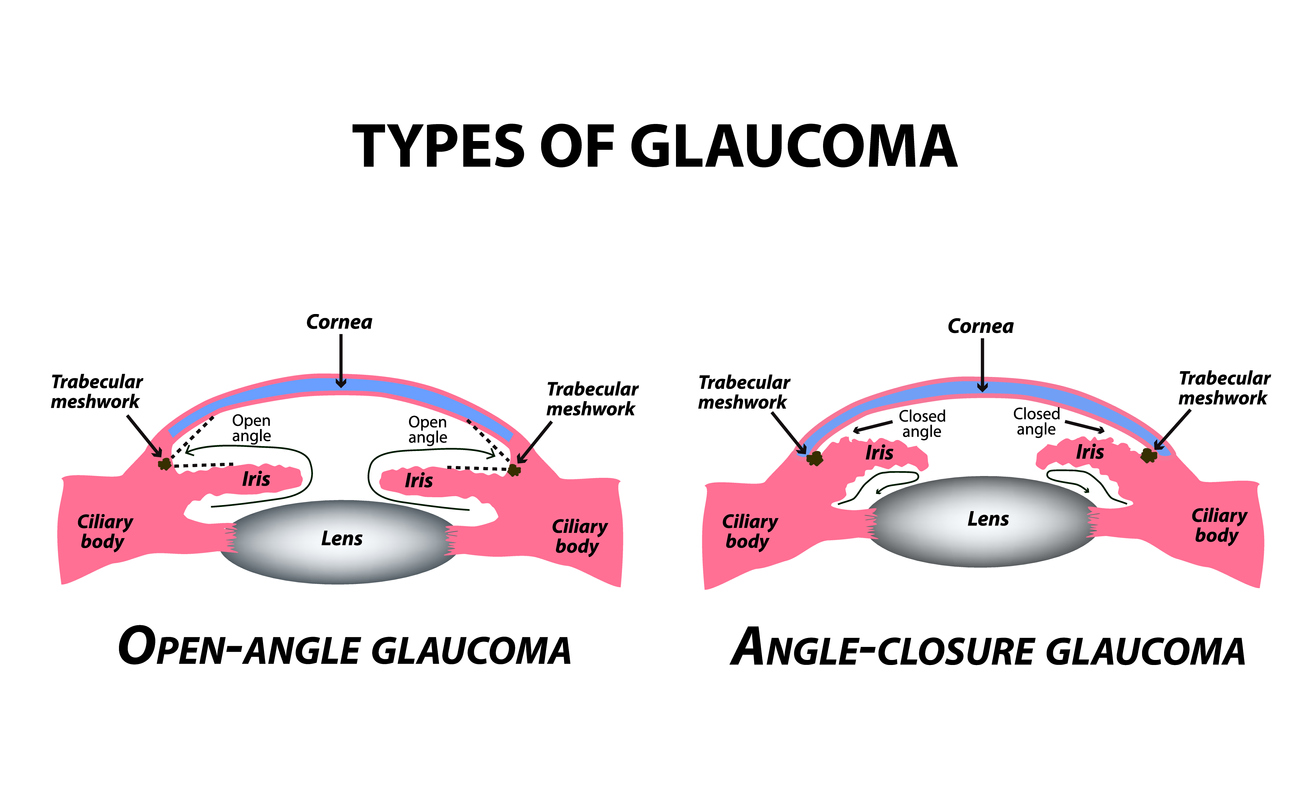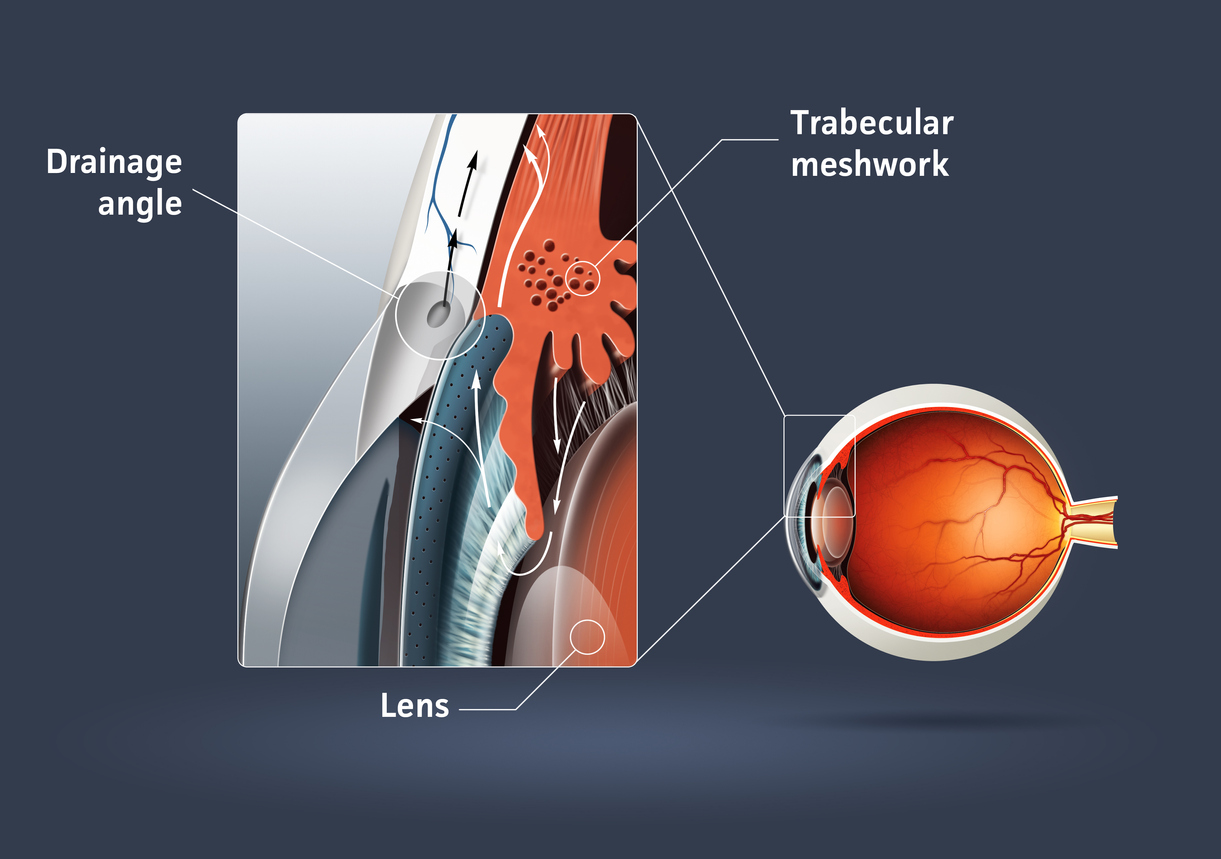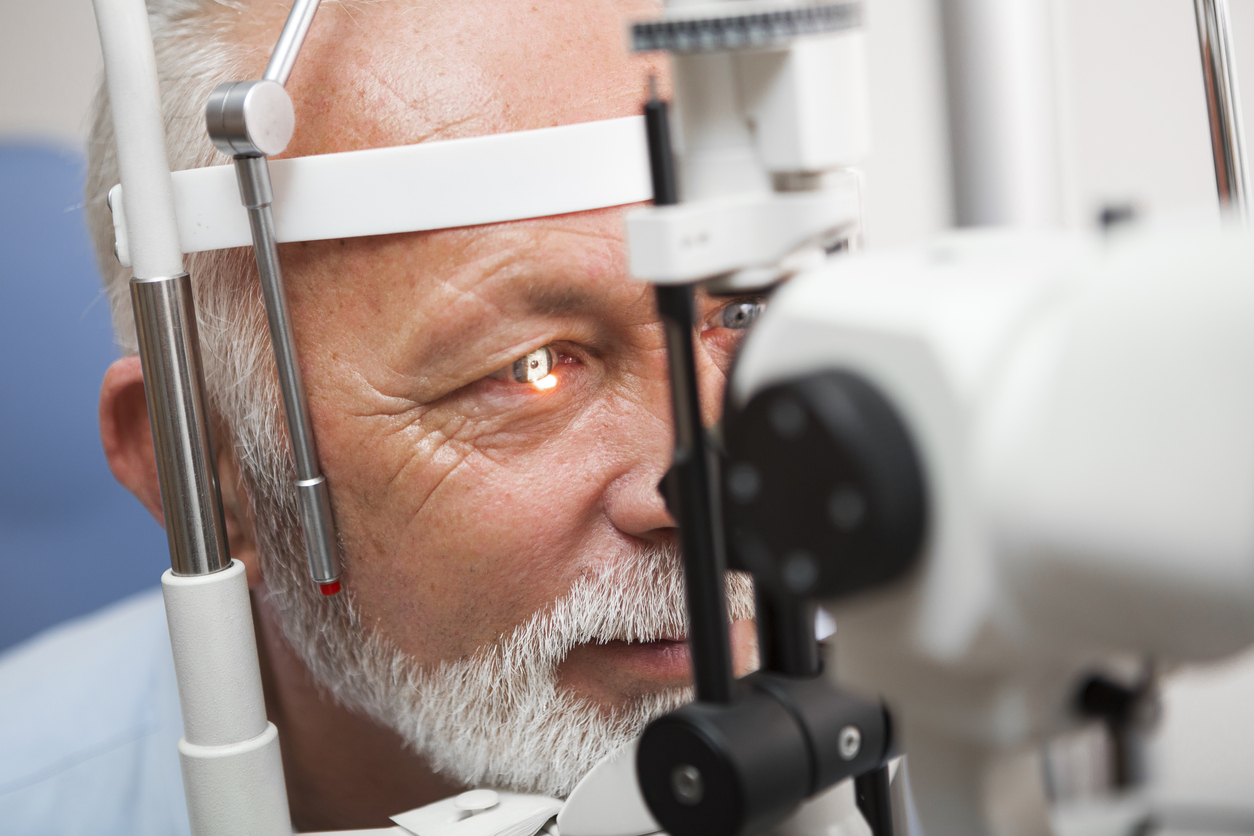 Half of those with glaucoma don’t even know they have it, according to the Glaucoma Research Foundation. They’re unaware because, in some instances, there may be no pain or noticeable symptoms. But, over time, vision loss can occur as a result of damage to the optic nerve. In fact, up to 40 percent of vision can be lost without a person even noticing. Sadly, that vision loss cannot be reversed.
Half of those with glaucoma don’t even know they have it, according to the Glaucoma Research Foundation. They’re unaware because, in some instances, there may be no pain or noticeable symptoms. But, over time, vision loss can occur as a result of damage to the optic nerve. In fact, up to 40 percent of vision can be lost without a person even noticing. Sadly, that vision loss cannot be reversed.
That makes early detection and treatment for glaucoma all the more important. Schedule a comprehensive eye exam with Dr. Benaim to help protect your eyes from permanent damage.
Book an appointment
What is Glaucoma | Causes | Symptoms | Diagnosing | Treatment | Prevention | Outlook | Summary | FAQ
What is Glaucoma?
There are two main types of glaucoma: open-angle glaucoma and angle-closure glaucoma. Open-angle glaucoma is the most common form and will often go undetected during the early stages. With open-angle glaucoma, the vision will slowly decrease over time and, eventually, can become severe enough to cause total vision loss.
Angle-closure glaucoma is the other main type of glaucoma. It is less common than open-angle glaucoma, but the damage to the optic nerve is more severe. Typically, the progression of angle-closure glaucoma is faster, and patients will be aware of it because it is usually painful and vision decreases faster.
As a result, it’s important to have regular eye exams and discuss your vision concerns with your eye doctor. Glaucoma may not be preventable, but early detection may be able to slow or halt the disease.
Both forms of glaucoma can cause damage to the optic nerve and as the disease progresses, the optic fiber nerves will look “cupped” as if someone has removed the center. As the loss of tissue progresses, it becomes visible to the doctor when examining the eye and easier to diagnose as glaucoma.
Causes of Glaucoma
 Doctors don’t truly understand the cause of glaucoma. The most popular belief is that glaucoma is directly related to the abnormalities of the drainage system within the eye. This drainage system, known as the “trabecular meshwork,” is responsible for removing fluid from the eye.
Doctors don’t truly understand the cause of glaucoma. The most popular belief is that glaucoma is directly related to the abnormalities of the drainage system within the eye. This drainage system, known as the “trabecular meshwork,” is responsible for removing fluid from the eye.
In open-angle glaucoma, the trabecular meshwork appears normal when examined, but doctors believe there are internal problems that will cause poor drainage of the eye fluid. When the trabecular meshwork fails to allow proper drainage, the pressure in the eye will increase and can cause the eye to inflate.
In angle-closure glaucoma, the trabecular meshwork may become blocked by the iris, abnormal blood vessels or scar tissue, which can also cause an increase in eye pressure. Increasing pressure on the eye may be one of the ways in which the optic nerve becomes damaged.
Many people who suffer from open-angle glaucoma have abnormally high eye pressures, suggesting that eye pressure is related to glaucoma damage. Some patients who have high pressure in their eyes do not experience glaucoma, but some patients who have no pressure will suffer from glaucoma.
Doctors believe that while eye pressure plays a role in glaucoma, to a certain extent, and lowering the eye pressure can be a helpful form of treatment, other unknown irregularities in the eye or the optic nerve also play a role in disease.
Glaucoma Symptoms
In open-angle glaucoma, there are often no clear symptoms for a patient to look for during the early stages. Eventually the disease advances into the later stages and increasing loss of vision will become apparent. A patient’s side vision may be lost, for example. Generally, the central vision remains strong, but will deteriorate over time, until a person is left with tunnel vision. Regular eye exams are encouraged so that patients can be screened for glaucoma.
Conversely, there are recognizable symptoms in angle-closure glaucoma. A person may suffer from periods of pain, ranging from minimal discomfort to an extreme aching pain in the eye and head. During the pain, the vision may become very blurred and, for this reason, people with angle closure often seek medical attention sooner, and are diagnosed with the disease earlier.
Diagnosing Glaucoma
 In order to determine if you have glaucoma, your eye doctor will perform a series of tests to determine your visual acuity. Your best vision with glasses will be checked, along with your eye pressure and the thickness of your corneas, as thinner corneas are a risk factor for glaucoma. Your pupils will also be tested, which can determine if your optic nerves are working properly.
In order to determine if you have glaucoma, your eye doctor will perform a series of tests to determine your visual acuity. Your best vision with glasses will be checked, along with your eye pressure and the thickness of your corneas, as thinner corneas are a risk factor for glaucoma. Your pupils will also be tested, which can determine if your optic nerves are working properly.
Your side vision will also be checked either by counting fingers within the edge of your vision, or through an automated visual field examination. A slit lamp exam will also be performed in order to examine the eye and the lens. It is possible that your eyes will be dilated, too, in order to perform a retinal exam.
As glaucoma develops into moderate or advanced stages, the optic nerve fibers are destroyed, causing the optic nerve to look as if it has been hollowed out. A loss of small sections of retinal nerves around the optic nerve, or small areas of bleeding on the optic nerve may also be noticeable. Additionally, if angle closure is present, Dr. Benaim may be able to see the iris or scar tissue physically blocking the trabecular drain.
Glaucoma Treatment
If glaucoma is caught early, it can be treated with eye drops to help lower the eye pressure. These medications generally work by decreasing the amount of fluid produced by the eye. Since less fluid is produced, there is less pressure on the eye. Other forms of eye drops work by allowing the fluid to drain out of the eye. The use of these drops can slow or even stop the formation of glaucoma. In some cases, eye drops are strong enough to delay the glaucoma from becoming worse, but, in cases where the eye drops are not working, you may need to undergo a form of glaucoma surgery.
The type of glaucoma surgery will vary depending on the severity of your condition. The surgical procedure to treat glaucoma is a small incision made into the drainage system of the eye. This new drainage system creates channels that will allow for a more normal flow of fluid.
A trabeculectomy allows the new system to work by removing part of the eye’s current drainage system. It’s a common non-laser procedure performed on glaucoma patients when other treatments, like their eye drops, are not working. The procedure involves creating a leak of fluid from the eye, which flows under the conjunctiva. A small bubble will appear on the conjunctiva at the point of intersection of the cornea and the sclera, where a valve will be made during the surgery.
Glaucoma Prevention
Early detection is critical to beginning glaucoma treatment, which is why it is important to visit your eye doctor regularly. The progression of glaucoma can be slowed down or possibly stopped, but once vision is lost, it can’t be restored.
Scheduling a regular eye exam might help prevent glaucoma — or another eye disease — from harming your vision. If your family has a history of glaucoma, or other eye diseases, it is vital that you seek the attention of an eye care specialist because patients with a family history of eye diseases are more likely to develop it, too.
To schedule an appointment with Dr. Benaim in Jupiter, Fla., please contact us at 561-747-7777.
Patient Outlook
The outlook for individuals with glaucoma depends on various factors, including the type and severity of the disease, the effectiveness of treatment and adherence to treatment regimens. While glaucoma cannot be cured, early detection and treatment can help slow down the progression of the disease and preserve vision. Regular monitoring by an eye care professional is essential for managing glaucoma and preventing vision loss. With proper management and adherence to treatment, many individuals with glaucoma can maintain their vision and quality of life.
Summary
Glaucoma is a progressive eye condition characterized by damage to the optic nerve, often associated with increased intraocular pressure. While open angle glaucoma (the most common form of glaucoma) may not present with noticeable symptoms in its early stages, regular eye examinations are essential for early detection and treatment. Treatment options for glaucoma aim to reduce intraocular pressure and prevent further damage to the optic nerve, and may include prescription eye drops, oral medications, laser therapy and surgical procedures. With early detection, proper management, and adherence to treatment, many individuals with glaucoma can preserve their vision and lead fulfilling lives.
Glaucoma FAQ
What is usually the first sign of glaucoma?
The early stages of glaucoma often do not present with noticeable symptoms, which is why it’s frequently referred to as the “silent thief of sight.” However, as the condition progresses, individuals may experience gradual loss of peripheral vision, blurred vision, halos around lights and difficulty adapting to low light conditions. Regular eye examinations by the experts at Benaim Eye and Aesthetics are crucial for detecting glaucoma in its early stages.
What age does glaucoma usually start?
Glaucoma can affect individuals of all ages, but it is more common in older adults, particularly those over the age of 40. However, certain types of glaucoma, such as congenital glaucoma, can occur in infants and young children. Regular eye examinations starting at age 40 or earlier if there are risk factors are essential for early detection and management of glaucoma.
Should I worry if I have glaucoma?
While glaucoma can lead to vision loss and blindness if left untreated, early detection and treatment can help slow down the progression of the disease and preserve vision. With proper management and regular monitoring, many individuals with glaucoma can maintain their vision their entire lives and lead fulfilling lives. It’s essential to follow the recommended treatment plan and attend regular eye examinations to ensure optimal outcomes.
Can I live a normal life with glaucoma?
Yes, most individuals with glaucoma live normal lives with proper management and treatment. Adhering to treatment regimens, attending regular eye examinations and making lifestyle modifications as recommended by the experts at Benaim Eye and Aesthetics can help patients maintain their vision and quality of life.
What is early-stage glaucoma?
Early-stage glaucoma refers to the initial stages of the disease when optic nerve damage and vision loss are minimal. In many cases, early-stage glaucoma may not present with noticeable symptoms, making regular eye examinations essential for early detection and management. With early intervention and treatment, progression of the disease can be slowed, preserving vision and quality of life.
Can drinking more water lower eye pressure?
While staying hydrated is essential for overall health, there is limited evidence to suggest that drinking more water can significantly lower eye pressure in individuals with glaucoma. It’s essential to follow the treatment plan recommended by the experts at Benaim Eye and Aesthetics to effectively manage eye pressure and prevent further damage to the optic nerve.
What is the fastest way to bring down eye pressure?
The fastest way to bring down eye pressure depends on the severity and underlying cause of the elevated pressure. Treatment options may include prescription eye drops, oral medications, laser therapy or surgical procedures. It’s essential to consult with the experts at Benaim Eye and Aesthetics to determine the most appropriate treatment approach for your specific needs and circumstances.
What drink is good for eye pressure?
While there is no specific drink known to lower eye pressure, staying hydrated with water and consuming a balanced diet rich in fruits and vegetables may support overall eye health. It’s essential to follow the treatment plan recommended by a professional to manage eye pressure effectively and to prevent further damage to the optic nerve.
What percentage of glaucoma patients go blind?
Without timely intervention and treatment, glaucoma can lead to vision loss and blindness. However, with proper management and regular monitoring, most individuals with the condition can maintain their vision and quality of life. It’s essential to attend regular eye examinations and follow the treatment plan recommended by the professionals at Benaim Eye and Aesthetics to prevent vision loss and preserve eye health.
What should glaucoma patients avoid?
Individuals with glaucoma should avoid activities that can increase intraocular pressure, such as heavy lifting, strenuous exercise and positions that involve straining, such as bending over or lifting heavy objects. Additionally, individuals with glaucoma should avoid smoking and limit caffeine intake, as these habits can increase eye pressure. Following a healthy lifestyle and adhering to the treatment plan recommended by the experts at Benaim Eye and Aesthetics are essential for managing their symptoms and preserving vision.
How long can you have glaucoma before you go blind?
The timeline for vision loss in glaucoma varies depending on factors such as the type and severity of the disease, response to treatment and adherence to treatment regimens. Without timely intervention and management, glaucoma can lead to vision loss and blindness over time, but this is rare with regular exams and following treatment plans. Proper treatment and regular monitoring are the reasons most individuals with glaucoma maintain their vision and quality of life.
Will I eventually go blind with glaucoma?
Without proper management and treatment, glaucoma can lead to vision loss and blindness over time. However, with early detection, timely intervention, and adherence to treatment regimens, most individuals with glaucoma maintain their vision and lead fulfilling lives. It’s essential to attend regular eye examinations and follow your treatment plan to prevent vision loss and preserve eye health.
Is watching TV bad for glaucoma?
While watching TV itself is not harmful for individuals with glaucoma, prolonged periods of screen time without breaks may contribute to eye strain and fatigue. It’s essential to take regular breaks, blink frequently and maintain a comfortable viewing distance when watching TV or using digital devices. Additionally, patients should follow the treatment plan recommended by the experts at Benaim Eye and Aesthetics to manage the condition effectively and to preserve vision.
What is the best vitamin to take for glaucoma?
While certain vitamins and antioxidants may support overall eye health, there is limited evidence to suggest that specific vitamins can prevent or treat glaucoma. It’s essential to follow a balanced diet rich in fruits, vegetables and nutrients to support overall eye health. Additionally, individuals with glaucoma should attend regular eye examinations and follow the treatment plan recommended by the professionals at Benaim Eye and Aesthetics to manage the condition effectively and to preserve vision.
Is glaucoma inherited?
While glaucoma can have a genetic component, it is not solely inherited. Other factors such as age, ethnicity and medical history can also contribute to its development. Individuals with a family history of glaucoma may be at higher risk for the condition and should undergo regular eye examinations to detect and manage the condition in its early stages.
Is glaucoma inherited from mother or father?
The risk of developing glaucoma can be influenced by genetic factors from both the mother and father’s side. While having a family history of glaucoma can increase the risk of developing the condition, other factors such as age, ethnicity and medical history also play a role.
Can you take vitamin D if you have glaucoma?
While vitamin D plays a crucial role in overall health, there is limited evidence to suggest that vitamin D supplementation can prevent or treat glaucoma. It’s important to follow a balanced diet rich in essential nutrients, including vitamin D, to support overall eye health. Additionally, individuals with glaucoma should attend regular eye examinations and follow their recommended treatment plan to effectively manage the condition and preserve vision.
Are bananas good for glaucoma?
Bananas are a nutritious fruit rich in potassium, which is essential for overall health. While there is no specific evidence to suggest that bananas are beneficial for glaucoma, consuming a balanced diet rich in fruits and vegetables can support overall eye health.
Does caffeine raise eye pressure?
Caffeine consumption may temporarily increase intraocular pressure in some individuals, but the effect is usually minor and short-lived. While moderate caffeine intake is generally safe for most individuals, those with glaucoma may want to limit their caffeine consumption or monitor their eye pressure closely.
How can I check my eye pressure at home?
It is not currently possible to check eye pressure safely and reliably at home without specialized equipment and training. Technology will likely make this possible in the coming years. Individuals with glaucoma can monitor their symptoms and visual changes and report any concerns to the experts at Benaim Eye and Aesthetics. Regular eye examinations are essential for monitoring eye pressure and detecting changes in vision or eye health. It’s essential to follow the treatment plan recommended by a professional to manage symptoms effectively and to preserve vision.
What is normal eye pressure for a 70-year-old?
Normal eye pressure can vary depending on factors such as age, ethnicity and medical history. While average eye pressure ranges from 10 to 21 mmHg, individual variations may occur.
What is the best position to sleep in to lower eye pressure?
Sleeping with the head elevated may help lower intraocular pressure in some individuals. However, there is limited scientific evidence to support specific sleep positions for lowering eye pressure.
What aggravates eye pressure?
Several factors can contribute to increased intraocular pressure, including physical exertion, stress, caffeine consumption and certain medications. Additionally, factors such as dehydration, poor sleep quality and eye strain may exacerbate eye pressure in some individuals.
Is coffee good for eye pressure?
While moderate caffeine consumption is generally safe for most individuals, excessive caffeine intake may temporarily increase intraocular pressure in some people. Individuals with elevated eye pressure may want to limit their caffeine consumption or monitor their eye pressure closely.
How do you massage your eyes to reduce pressure?
Gentle eye massage may help alleviate eye strain and promote relaxation, but it is essential to proceed with caution to avoid causing damage to the eyes. To massage your eyes, start by closing your eyes and placing your fingertips lightly on your eyelids. Gently apply pressure in a circular motion, moving from the inner corner of the eye to the outer corner. Repeat several times, then relax and take deep breaths. Do not excessively press on your eyes while doing this massage, as this has been shown to raise eye pressure.
Sources:
1 “January is Glaucoma Awareness Month,” Glaucoma Research Foundation, Web, Accessed March 2019 (https://www.glaucoma.org/news/glaucoma-awareness-month.php)
 New Address:
New Address: